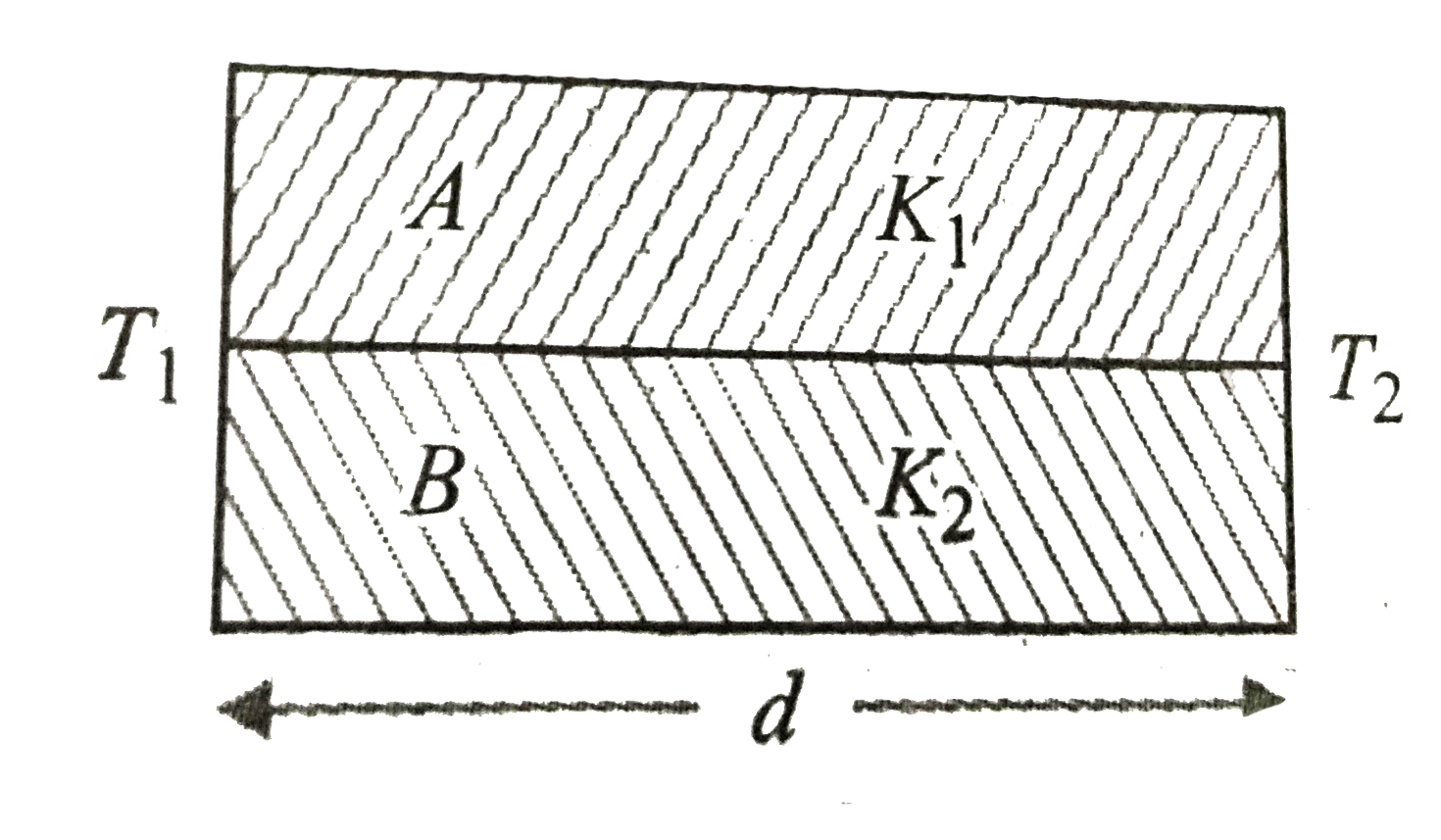Two identical vessels, made of different materials having conductivites K1 and K2 are completely filled with ice at 0∘C. Due to temperature of surrounding, the ice in the two vessels melts in 25min and 20min respectively. The ratio of K1 and K2 is
5/4
4/5
16/25
4/5√(5/4)
To solve the problem, we need to apply the principles of heat transfer through conduction. The heat transfer rate through a material is given by Fourier's law of heat conduction, which states:
dQdt=K⋅A⋅ΔTd
Where:
- dQdt is the rate of heat transfer,
- K is the thermal conductivity of the material,
- A is the area through which heat is being transferred,
- ΔT is the temperature difference across the material,
- d is the thickness of the material.
Step 1: Understand the scenario
We have two identical vessels made of different materials with thermal conductivities K1 and K2. Both vessels are filled with ice at 0∘C and are subjected to the same surrounding temperature, causing the ice to melt.
Step 2: Relate melting time to heat transfer
The time taken for the ice to melt is directly related to the amount of heat transferred. The heat required to melt the ice can be expressed as:
Q=m⋅Lf
Where:
- m is the mass of the ice,
- Lf is the latent heat of fusion for ice.
Step 3: Set up the equations for heat transfer
For the first vessel (with conductivity K1):
Q1t1=K1⋅A⋅ΔTd
Where t1=25 min=1500 sec.
For the second vessel (with conductivity K2):
Q2t2=K2⋅A⋅ΔTd
Where t2=20 min=1200 sec.
Step 4: Set the heat transfer equal to the heat required to melt the ice
Since the amount of heat Q required to melt the ice is the same for both vessels, we can write:
m⋅Lf=K1⋅A⋅ΔTd⋅t1
m⋅Lf=K2⋅A⋅ΔTd⋅t2
Step 5: Equate the two expressions
Setting the two equations equal to each other gives:
K1⋅A⋅ΔTd⋅t1=K2⋅A⋅ΔTd⋅t2
Step 6: Simplify the equation
Since A, ΔT, and d are common in both equations, we can cancel them out:
K1⋅t1=K2⋅t2
Step 7: Solve for the ratio of conductivities
Rearranging gives us:
K1K2=t2t1
Substituting the values for t1 and t2:
K1K2=12001500=45
Final Answer
The ratio of thermal conductivities K1 and K2 is:
K1K2=45
- dQdt is the rate of heat transfer,
- K is the thermal conductivity of the material,
- A is the area through which heat is being transferred,
- ΔT is the temperature difference across the material,
- d is the thickness of the material.
We have two identical vessels made of different materials with thermal conductivities K1 and K2. Both vessels are filled with ice at 0∘C and are subjected to the same surrounding temperature, causing the ice to melt.
The time taken for the ice to melt is directly related to the amount of heat transferred. The heat required to melt the ice can be expressed as:
- m is the mass of the ice,
- Lf is the latent heat of fusion for ice.
For the first vessel (with conductivity K1):
Q1t1=K1⋅A⋅ΔTd
Where t1=25 min=1500 sec.
Q2t2=K2⋅A⋅ΔTd
Where t2=20 min=1200 sec.
Since the amount of heat Q required to melt the ice is the same for both vessels, we can write:
m⋅Lf=K2⋅A⋅ΔTd⋅t2
Setting the two equations equal to each other gives:
Since A, ΔT, and d are common in both equations, we can cancel them out:
Rearranging gives us:
The ratio of thermal conductivities K1 and K2 is:
Topper's Solved these Questions
Similar Questions
Two identical metal wires of thermal conductivities K1 and K2 respectively are connected in series. The effective thermal conductivity of the combination is :
View SolutionTwo vessels 1 and 2, made out of different materials are identical in all the geometrical aspects. In both the vessel the same quantity of ice gets melted in 20 min and 30 min respectively. The ratio of the thermal conductivity of the second one to that of the first is
View Solution
Knowledge Check
- Question 1 - Select One
Two identical rods are made of different materials whose thermal conductivities are K1andK2. They are placed end to end between two heat reservoirs at temperatures θ1andθ2. The temperature of the junction of the rod is
 Aθ1+θ22BK1θ1+K2θ2K1+K2CK1θ2+K2θ1K1+K2DK1θ1+K2θ2[K1−K2]
Aθ1+θ22BK1θ1+K2θ2K1+K2CK1θ2+K2θ1K1+K2DK1θ1+K2θ2[K1−K2] - Question 2 - Select One
Two identical rods with different thermal conductivities k1 & k2 and different temperatures are first placed along length and then along area, then the ratio of rates of heat flow in both cases is
Ak1+k2k1+k2B4k1k2(k1+k2)2C(k1+k2)24k1D4k1k2(k1+k2)2 - Question 3 - Select One
A slab consists of two parallel layers of two different materials of same thickness having thermal conductivities K1andK2. The equivalent conductivity of the combination is
AK1+K2BK1+K22C2K1K2K1+K2DK1+K22K1K2
A slab consists of two layers of different materials of the same thickness and having thermal conductivities K1 and K2. The equivalent thermal conductivity of the slab is
View SolutionTwo bars of same length and same cross-sectional area but of different thermal conductivites K1 and K2 are joined end to end as shown in the figure. One end of the compound bar it is at temperature T1 and the opposite end at temperature T2 (whereT1>T2). The temperature of the junction is
 View Solution
View SolutionTwo rods of length d1 and d2 and coefficients of thermal conductivites K1 and K2 are kept touching each other. Both have the same area of cross-section. The equivalent thermal conductivity.
View SolutionTwo rods A and B of different materials are welded together as shown in figure. Their thermal conductivities are K1 and K2. The thermal conductivity of the composite rod will be
 View Solution
View SolutionTwo rods A and B of different materials are welded together as shown in figure. Their thermal conductivities are K1 and K2. The thermal conductivity of the composite rod will be
 View Solution
View Solution

